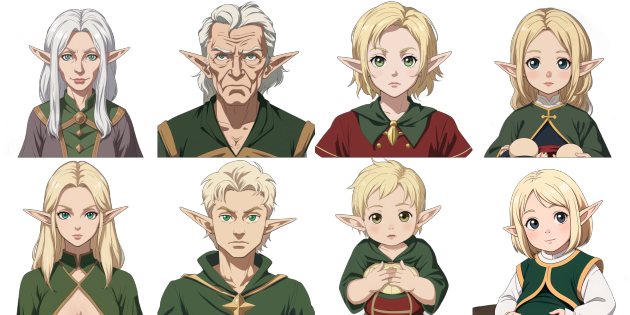The concept of cultural exchange often invokes thoughts of varied human traditions, practices, and beliefs. However, what if we broadened our scope to include entities from myth and lore, such as elf families? This intriguing notion prompts us to explore not only the enchanting aspects of elvish cultures but also the transformational potential this exchange could hold for humanity. The mere idea of interacting with an elvish family beckons curiosity, challenging our perceptions of reality and inviting us into a realm of fascination.
To comprehend the breadth of cultural exchange with an elf family, we must first delve into the origins and traditions commonly associated with these ethereal beings. In many mythologies, elves epitomize a deep connection with nature, possessing unparalleled wisdom and an innate understanding of the environment. Their lives are often interwoven with the flora and fauna, emphasizing harmony and respect for the earth. Such cultural characteristics, grounded in their existence, harbor lessons pertinent to today’s ecological concerns. Engaging with an elf family could illuminate alternative lifestyles that prioritize sustainability and balance, particularly invaluable lessons in an age marked by environmental degradation and climate threats.
Furthermore, elves traditionally embody exceptional artistry, from exquisite craftsmanship to enchanting music. Their creativity often reflects their surroundings, emphasizing their profound appreciation of beauty in nature. A cultural exchange with an elf family could unveil unique artistic expressions that challenge conventional thought. Imagine learning the ancient art of nature-inspired crafts, where materials are sourced sustainably, and every creation carries an ethical imprint. This artistic exchange could foster a renewed appreciation for the value of handmade creations versus mass-produced goods, nurturing a deeper understanding of responsible consumption.
Additionally, the narrative around elven societies often includes complex systems of governance rooted in collective decision-making and deep respect for the wisdom of the elders. This collectivist approach starkly contrasts with the more individualistic tendencies observed in many human societies. Engaging with an elf family could reveal alternative governance models that prioritize consensus and community well-being, potentially igniting dialogues about social structures and governance in our own communities. Such insights could, in turn, encourage more collaborative and inclusive practices, fostering stronger community ties and mutual respect among individuals.
The lessons gleaned from an elf family might also extend to personal philosophies and ways of living. Elves are often characterized by their longevity, experiencing life through a lens that many humans may find elusive. Their perspectives on time, growth, and existence are often more fluid and expansive, fostering a contemplative approach to life. Through their worldview and interactions, humans might cultivate greater mindfulness, receptiveness to change, and an appreciation for life’s fleeting moments. Such an exchange could be particularly enlightening in a fast-paced world that often prioritizes productivity over introspection and connection.
An integral aspect of this exchange would undeniably involve language and communication. Elves are frequently depicted as possessing languages that resonate with the natural world—languages that carry the melodies of leaves rustling or rivers flowing. Engaging with an elf family would not only give insight into their vernacular but also encourage an exploration of language’s role in shaping thought and culture. This linguistic exchange might unveil how different terminologies can encapsulate concepts that may otherwise be overlooked or underappreciated in contemporary human languages, prompting a reevaluation of communication and understanding in our daily lives.
Moreover, an elf family’s world is often imbued with magic and mystique, which serves not merely as entertainment but as a metaphor for exploring the boundaries of reality. Such encounters can provoke questions about belief systems, the nature of existence, and humanity’s place in the cosmic tapestry. For instance, do elves view their type of magic as a mere tool or as a profound reflection of the interconnectedness of all life? These discussions could inspire humans to reflect on their own beliefs, challenge dogmas, and embrace curiosity about the manifold meanings of life.
As we consider the potential for cultural exchange with an elf family, it is crucial to acknowledge the manner in which such interactions unfold. Genuine cultural exchange requires mutual respect and openness. Just as elvish families might be reticent to share aspects of their culture, so too must humans demonstrate an earnest desire to learn and understand. This reciprocal exchange can foster trust and enhance the overall experience for both parties, ensuring that the interaction is meaningful and enriching.
In conclusion, the idea of engaging in a cultural exchange with an elf family offers more than whimsical escapism; it invites profound reflections on our existence, values, and interactions with the world around us. This fantasy framework serves as a compelling apparatus for reimagining our relationship with nature, society, and creativity. As curiosity moves us toward this intersection of reality and imagination, we may indeed uncover lessons that resonate deeply with pressing issues of our time. Embracing this possibility could lead to a paradigm shift, fostering a richer appreciation for the myriad ways of life that exist, even beyond our earthly realm.
